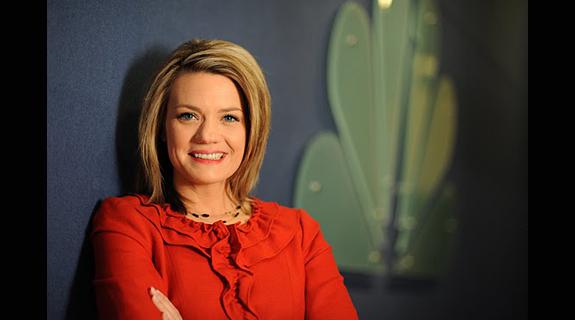In our most recent Station Summit social case study, we looked at KTTV Fox 11 and its rise to the top of the Google+ platform via Google Hangouts. Today, in our last study leading up to Thursday’s Station Summit session, “Tales from the Lost Remote: How TV Stations Can Capitalize on Mobile and Social TV,” we look at an individual who pioneered the use of Google Hangouts in the local newsroom…not to create bonus social media content, but as a live on-air reporting and broadcasting tool in and of itself.
The group video chat service Google Hangouts came into being when Veterans United chief storyteller Sarah Hill was an anchor at mid-Missouri NBC affiliate KOMU-TV. Working with broadcast journalism students from the University of Missouri, she found it a useful learning tool that enabled her to bring them behind the scenes of a newscast while continuing to interact with them in the moment.
“I thought, ‘wouldn’t it be interesting to have a visual back channel where you could see and hear your news audience?’” Hill told Brief. She decided to take the Hangout feature one step further, bringing not just students but KOMU News viewers into the newscast. “I opened up a Hangout and the world flooded in,” she said. “[Viewers] enjoyed the ability to talk to their local news anchor and they enjoyed consuming the news in an interactive way, and then having the ability for the anchor to talk back.”
Hangouts allow up to nine people to join a video chat, plus the host. Users can have private chats or use Google’s “On Air” mode, in which case the chats are streamed to YouTube for free for the entire world to see. When applied to a newscast, “it’s almost like [the chat participants] are in your studio, but they are a live online audience,” said Hill.
Unlike text-based real-time social platforms, such as Facebook or Twitter, Hangouts allowed Hill to communicate with her viewers “face to face. I can see your body language, see what’s behind you,” she said. “The level of engagement is far deeper than any text-based post.”
Where some stations have used Hangouts to supplement the on-air news broadcast, Hill was the first to merge the service with the broadcast itself. As KOMU’s interactive news anchor, she wore a microphone in each ear, one to communicate with her studio news team, the other to communicate with that day’s nine vetted Google Hangout participants. The system extended the Missouri station’s reach to an international audience and drew legions of people around the globe to start following KOMU on Google+.
But despite the increase in followers, the station ended the interactive newscasts and Sarah Hill moved on to her current position at Veterans United.
“A local news station wasn’t interested in an international audience,” explained Hill. “It can only sell ads to Missouri. We gained tens of thousands of international followers, but what does a local station do with that? No one on the platform has figured out how to serve those international followers yet.”
But while stations haven’t yet figured out how to monetize Hangouts, Hill still sees the feature as a valuable promotional tool. “[For SEO purposes,] every time you use a Google Hangout, your Google+ feed posts faster than Twitter or Facebook,” she said. “Your Google+ post will show up and Facebook and Twitter aren’t even there yet. Stations need to pay attention and post on this platform with those hashtags because it boosts your [Google search] ranking every time you use it. Any station that has any digital properties wants to pay attention to the largest search engine. You want to be found.”
At Veterans United, Hill’s advocacy for Google Hangouts remains undiminished. These days, she uses the service to connect US service members, veterans and their families from around the world by sharing their stories. Through a feature called Veterans Virtual Tours, she gives disabled, aging and terminally ill veterans an in-depth digital look at memorials built in their honor.
As a storytelling and reporting implement, Hill believes Hangouts can, and already are, changing the world for the better.
“It’s a free satellite truck right in the middle of a crowdsourcing tool,” she said. “Together they create this broadcasting stick. You can also crowdsource an audience. [For instance, at Veterans United] you can find veterans on this platform simply by searching for ‘veterans’ and reaching out and interacting with them. You can search individual posts. If you want to find someone who is posting pics, posts etc. on breaking news, you can reach out to them and invite them to join in the Google Hangout. The hangouts give people the ability to show what they’re seeing and bring others into the conversation. They give anyone with a 4G or 3G connection the ability to broadcast. It used to be you needed special privileges to go live on YouTube. Now that’s open to anyone. For third-world countries imagine what that’s going to do for countries like the US as far as awareness [of their plight]. It’s reducing the physical space between people.”
Tags:













































__twocolumncontent.jpg)











